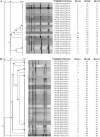Evaluation of multiple-locus variable-number tandem-repeat analysis for typing a polyclonal hospital-acquired methicillin-resistant Staphylococcus aureus population in an area where such infections are endemic
- PMID: 20519480
- PMCID: PMC2916587
- DOI: 10.1128/JCM.02220-09
Evaluation of multiple-locus variable-number tandem-repeat analysis for typing a polyclonal hospital-acquired methicillin-resistant Staphylococcus aureus population in an area where such infections are endemic
Abstract
Multiple-locus variable-number tandem-repeat analysis (MLVA) was performed with 292 methicillin-resistant Staphylococcus aureus (MRSA) isolates previously characterized by pulsed-field gel electrophoresis, multilocus sequence typing, and staphylococcal cassette chromosome mec typing. Quantitative correspondence analyses showed the best correlation between data when an >or=80% cutoff was applied to MLVA. We confirmed the validity of MLVA for identification of related strains in a polyclonal MRSA population.
Figures

Similar articles
-
Comparison of fingerprinting methods for typing methicillin-resistant Staphylococcus aureus sequence type 398.J Clin Microbiol. 2009 Oct;47(10):3313-22. doi: 10.1128/JCM.00910-09. Epub 2009 Aug 26. J Clin Microbiol. 2009. PMID: 19710273 Free PMC article.
-
Multiple-locus variable-number tandem-repeat analysis of meticillin-resistant Staphylococcus aureus discriminates within USA pulsed-field gel electrophoresis types.J Hosp Infect. 2009 Apr;71(4):333-9. doi: 10.1016/j.jhin.2008.12.011. Epub 2009 Feb 5. J Hosp Infect. 2009. PMID: 19200620 Free PMC article.
-
Comparison of two multilocus variable-number tandem-repeat methods and pulsed-field gel electrophoresis for differentiating highly clonal methicillin-resistant Staphylococcus aureus isolates.J Clin Microbiol. 2010 Oct;48(10):3600-7. doi: 10.1128/JCM.01039-10. Epub 2010 Aug 11. J Clin Microbiol. 2010. PMID: 20702668 Free PMC article.
-
Can MLVA Differentiate among Endemic-Like MRSA Isolates with Identical Spa-Type in a Low-Prevalence Region?PLoS One. 2016 Feb 9;11(2):e0148772. doi: 10.1371/journal.pone.0148772. eCollection 2016. PLoS One. 2016. PMID: 26859765 Free PMC article.
-
The evolution of Staphylococcus aureus.Infect Genet Evol. 2008 Dec;8(6):747-63. doi: 10.1016/j.meegid.2008.07.007. Epub 2008 Jul 29. Infect Genet Evol. 2008. PMID: 18718557 Review.
Cited by
-
Adjusted Wallace coefficient as a measure of congruence between typing methods.J Clin Microbiol. 2011 Nov;49(11):3997-4000. doi: 10.1128/JCM.00624-11. Epub 2011 Sep 14. J Clin Microbiol. 2011. PMID: 21918028 Free PMC article.
-
Genotyping of Staphylococcus aureus strains isolated from healthy persistent carriers.Folia Microbiol (Praha). 2014 Jul;59(4):349-53. doi: 10.1007/s12223-013-0294-y. Epub 2014 Feb 2. Folia Microbiol (Praha). 2014. PMID: 24488811
-
An improved MLVF method and its comparison with traditional MLVF, spa typing, MLST/SCCmec and PFGE for the typing of methicillin-resistant Staphylococcus aureus.Int J Mol Sci. 2014 Jan 8;15(1):725-42. doi: 10.3390/ijms15010725. Int J Mol Sci. 2014. PMID: 24406728 Free PMC article.
References
-
- Abramson, M. A., and D. J. Sexton. 1999. Nosocomial methicillin-resistant and methicillin-susceptible Staphylococcus aureus primary bacteremia: at what costs? Infect. Control Hosp. Epidemiol. 20:408-411. - PubMed
-
- Chaberny, I. F., F. Schwab, S. Ziesing, S. Suerbaum, and P. Gastmeier. 2008. Impact of routine surgical ward and intensive care unit admission surveillance cultures on hospital-wide nosocomial methicillin-resistant Staphylococcus aureus infections in a university hospital: an interrupted time-series analysis. J. Antimicrob. Chemother. 62:1422-1429. - PubMed
-
- Crisóstomo, M. I., H. Westh, A. Tomasz, M. Chung, D. C. Oliveira, and H. de Lencastre. 2001. The evolution of methicillin resistance in Staphylococcus aureus: similarity of genetic backgrounds in historically early methicillin-susceptible and -resistant isolates and contemporary epidemic clones. Proc. Natl. Acad. Sci. U. S. A. 98:9865-9870. - PMC - PubMed
-
- Crossley, K., B. Landsman, and D. Zaske. 1979. An outbreak of infections caused by strains of Staphylococcus aureus resistant to methicillin and aminoglycosides. II. Epidemiologic studies. J. Infect. Dis. 139:280-287. - PubMed
Publication types
MeSH terms
LinkOut - more resources
Full Text Sources
Medical

